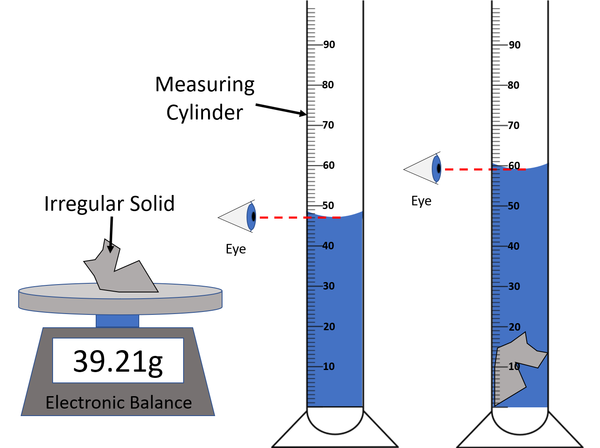Difference between revisions of "GCSE Physics Required Practical: Calculating Densities"
(→Improving Precision) |
(→Improving Precision) |
||
| Line 46: | Line 46: | ||
====Improving [[Precision]]==== | ====Improving [[Precision]]==== | ||
| − | : Use a larger [[ | + | : Use a larger and more massive cuboid to reduce the [[uncertainty]] of the [[Electronic Balance|electronic balance]] and the [[Measuring Cylinder|measuring cylinder]] so that repeat readings are likely to be the same given the [[resolution]] of the instruments. |
| + | : Ensure no [[water]] is spilled from the [[Measuring Cylinder|measuring cylinder]] so that all repeat readings are the same. | ||
| + | : Measure the 'dry' [[mass]] of the [[object]] to ensure repeat readings are not affected by [[water]] permeating the [[object]]. | ||
Revision as of 08:33, 17 October 2019
Contents
Key Stage 4
Meaning
Finding the density of solid objects.
Experiment 1: Cuboid
Method
| A diagram of the apparatus used in an experiment to find the density of a cuboid. |
- Measure the mass of the cuboid using an electronic balance or measuring scale.
- Measure the length, width and height of the cuboid using a ruler.
- Multiply the length, width and height to calculate the volume.
- Use the equation \(\rho = \frac{m}{V}\) to calculate the density of the cuboid.
Improving Accuracy
- Place the electronic balance on a flat, level surface to get an accurate reading of the mass.
Improving Precision
- Use a larger and more massive cuboid to reduce the uncertainty of the electronic balance and the ruler so that repeat readings are likely to be the same given the resolution of the instruments.
Experiment 1: Irregular Solid
Method
| A diagram of the apparatus used in an experiment to find the density of an irregular solid. |
- Measure the mass of the object using an electronic balance or measuring scale.
- Fill a measuring cylinder with enough water to submerse the object.
- Take a reading of the volume of water in the Measuring Cylinder.
- Place the object in the Measuring Cylinder and ensure it is submersed.
- Take a reading of the volume of water + object in the Measuring Cylinder.
- Subtract the volume of water from the volume of water + object to find the volume of the object.
- Use the equation \(\rho = \frac{m}{V}\) to calculate the density of the irregular object.
Improving Accuracy
- Ensure the mass is measured at the start of the experiment so that the mass is measured while the object is dry.
- Place the electronic balance on a flat, level surface to get an accurate reading of the mass.
- Place the measuring cylinder on a flat, level surface and read it from eye level to get an accurate reading of the volume of water.
Improving Precision
- Use a larger and more massive cuboid to reduce the uncertainty of the electronic balance and the measuring cylinder so that repeat readings are likely to be the same given the resolution of the instruments.
- Ensure no water is spilled from the measuring cylinder so that all repeat readings are the same.
- Measure the 'dry' mass of the object to ensure repeat readings are not affected by water permeating the object.

